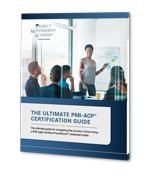Fundamentals of Agile Coaching
I have been a project manager and instructor for many years and in this capacity, I have often had to coach and/or mentor team members, especially junior project managers. I had never actually been trained in either coaching or mentoring, so I provided the kind of insight I would have liked to have gotten when I was starting out. But recently I gained an Agile coaching certification from an organization called IC-Agile. This involved taking a two-day, interactive class along with a few outside-the-class webinars. I’ve also now been involved in Agile coaching for a customer and have read some great books about it.

Download the Ultimate Guide to learning about the PMI-ACP Certification.
Agile Coach, Not a Life Coach
The first thing to understand is an Agile coach is not a life coach. His or her job is to instill the fundamentals of Agile, or what we might call the Agile mindset, in those whom he or she coaches.
Perhaps the best way to illustrate the Agile mindset is to talk about Scrum values. Scrum is a leading type of Agile. Per the 2017 Scrum Guide:
“When the values of commitment, courage, focus, openness, and respect are embodied and lived by the Scrum Team, the Scrum pillars of transparency, inspection, and adaptation come to life and build trust for everyone. The Scrum Team members learn and explore those values as they work with the Scrum events, roles, and artifacts.
Successful use of Scrum depends on people becoming more proficient in living these five values. People personally commit to achieving the goals of the Scrum Team. The Scrum Team members have the courage to do the right thing and work on tough problems. Everyone focuses on the work of the Sprint and the goals of the Scrum Team. The Scrum Team and its stakeholders agree to be open about all the work and the challenges with performing the work. Scrum Team members respect each other to be capable, independent people.” 1
I’ll use a particular example to illustrate how an Agile coach might help.
Traditional Waterfall to Agile
Let’s say I have been brought into an organization to help perform an Agile transformation. What this means is a company has decided to go fully into Agile from traditional waterfall project management. This is not an easy transition as the entire mindset of the organization has to change.
Some of the important considerations for the Agile coach to impart in the organization include:
- Moving from a command-and-control mindset to one of self-organizing teams. Team members commit to each other in a daily stand-up and decide how they will get work done.
- Moving towards servant leadership. A Servant Leader shares responsibility and puts the needs of the team first while also helping colleagues develop and perform as effectively as possible.
- There is no such role as a project manager. This means there is no one who is driving the team to get things done, laying out tasks, and checking up on them. This is the team’s job to do.
- There is a Scrum Master who is not a project manager. His or her job is to facilitate the team’s work and get impediments out of their way.
- It is not necessarily a given that a project manager will automatically transition into the Scrum Master role. It can be difficult to “let go.”
- There is a lot less paperwork. As the Agile Manifesto states, “We have come to value working software over comprehensive documentation.”
- There are daily meetings with the business to work collaboratively.
- The business – product owners specifically – have to learn to trust the system.
- Senior management must let the team work at its pace, trusting – the keyword again –the team will start to perform at its optimal level.
While it may not seem obvious, there are some fundamental changes described in the bullets above. Most significantly is moving away from command-and-control towards servant leadership. This can be especially challenging for management, who will want to send a “get things done” type of PM into a role which by definition requires a facilitator.
Additionally, some people have a hard time believing a team can become self-organizing and need someone – they believe – to drive the team forward. This too is a learned behavior.
Now, if we go back to the initial scenario of a company who wants to perform a transition, what exactly does the Agile coach do? What is his or her function?
Essentially, it’s to propagate and spread the Agile mindset throughout the company, all the while being cognizant of the fact people are resistant to change. And this must occur at all levels of the organization or there will be a return to the old behavior. Agile Coaching is a great way to optimize an organization’s operations, but it requires an all-in approach.
1. The Scrum Guide™, ©2017, Ken Schwaber and Jeff Sutherland. https://www.scrum.org/resources/scrum-guide
Studying for the PMP Exam?
Upcoming PMP Certification Training – Live & Online Classes
: Widget class not found. Make sure this widget exists and the class name is correct



 New Horizons
New Horizons
 Project Management Academy
Project Management Academy
 Six Sigma Online
Six Sigma Online
 Velopi
Velopi
 Watermark Learning
Watermark Learning
 Login
Login



 New Horizons
New Horizons
 Project Management Academy
Project Management Academy
 Velopi
Velopi
 Six Sigma Online
Six Sigma Online
 Watermark Learning
Watermark Learning